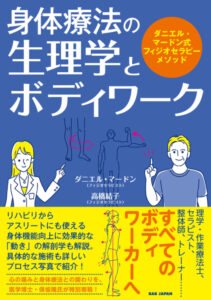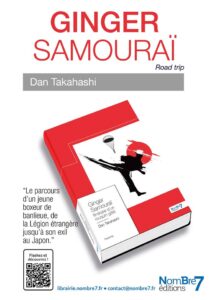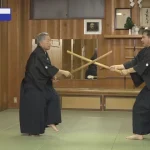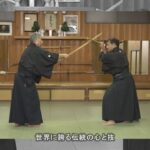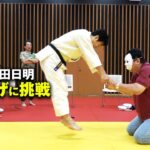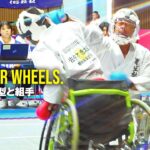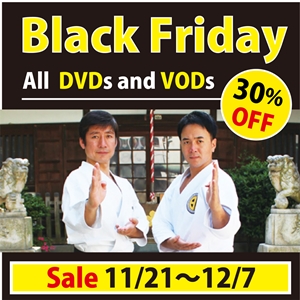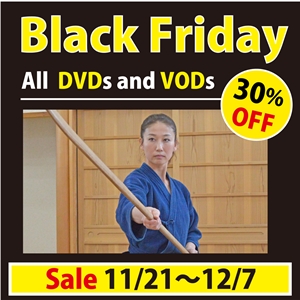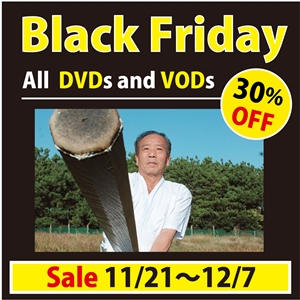【Exploring the spirit of the Ryukyu】Special edition KOBUDO World Championships (HIDEN 10/2024)
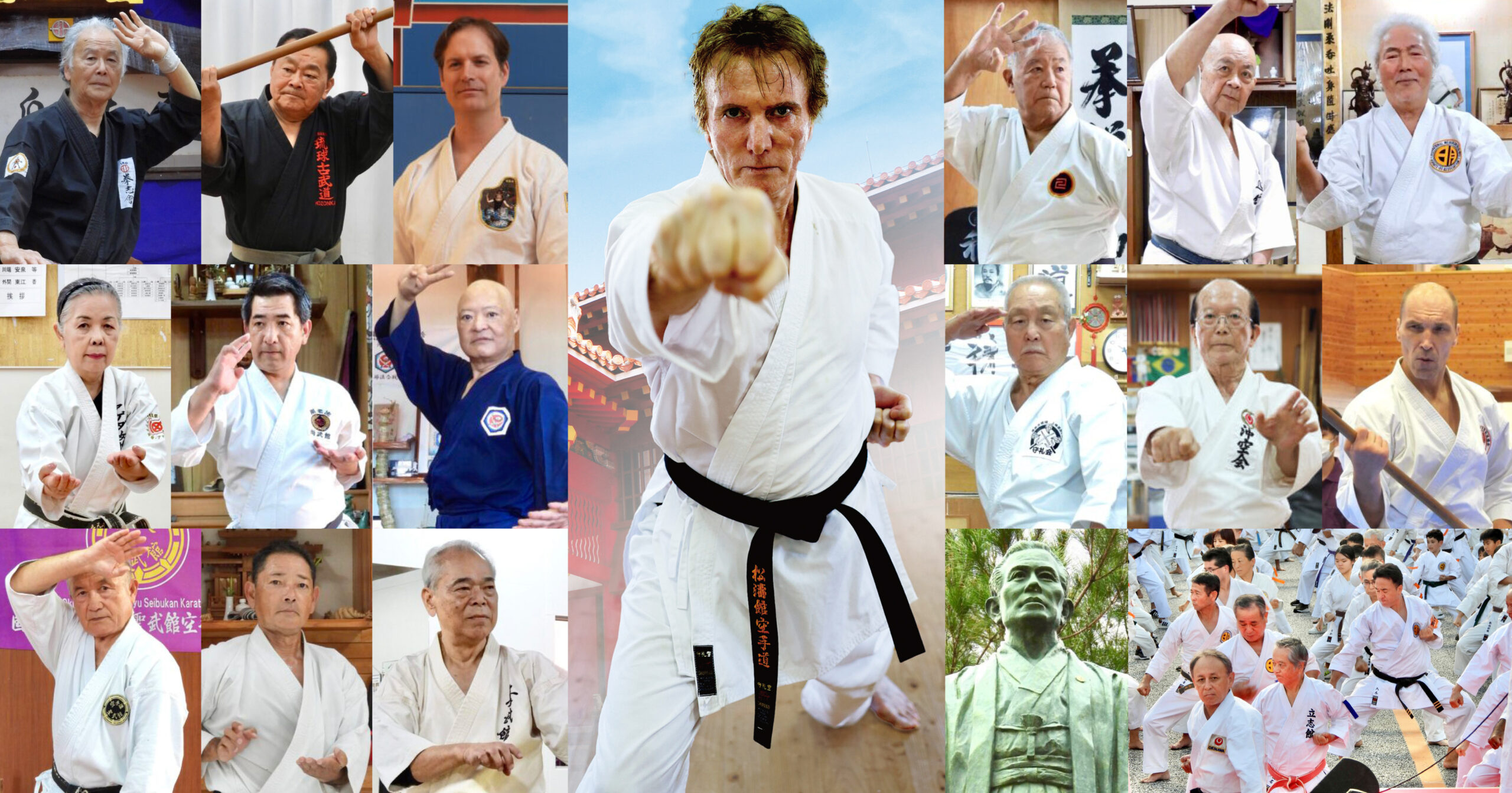
2024 Okinawa Traditional Kobudo World Championships
These 2024 Okinawa Traditional Kobudo World Championships were the first ones since pre-Covid (2019). The event was conducted August 3rd & 4th at the Karate Kaikan and the attendance was pretty good with at least 17 countries represented and over 200 participants.
Interview/text: Daniel Mardon
Photography/Translation ◎Yuko Takahashi
A Two-day battle
As we arrived early the first morning, many participants were already waiting at the entrance and the heat was already on due to the bright Okinawa Summer Sun…
Shimabukuro Tsuneo Sensei who is 10th Dan of Uechi-Ryu Karate & 10th Dan of Kobudo, is the Chairman of the “Okinawa Kobudo Federation”. He was chosen to be the President for these 2024 Kobudo World Championships. Shimabukuro Sensei brought together several teams from different groups of contemporary famous Kobudo practitioners who gathered from all over the world.
The main Hombu Dojo were represented by the most famous Okinawa Kobudo Grand Masters of our time. Among them were the three “Intangible cultural assets” designated by Okinawa Prefecture; Nakamoto Masahiro, Iha Kotaro and Higaonna Morio, as well as other Karate assets such as Yagi Meitatsu, Nakazato Minoru, Ikemiyagi Masaaki, Tamayose Hidemi, Arakaki Takashi, Kuniyoshi Yukio Sensei. Many more Sensei from Karate and other martial arts were present and it made this tournament very precious.
The opening ceremony was very impressive with the presence of Okinawa Governor “Denny” Tamaki who is himself a great Karate practitioner. After his introduction speech, a formal proclamation and oath were made by the athlete’s representative which gave the start for this 2-day World tournament.
The different delegations were lined up by group-name affiliations which were subdivided by countries. They all faced the tribune where the Grand Masters and Governor Tamaki were standing. Next, we had the immense joy of watching a luxurious demonstration program performed by the very same Grand Masters who changed from official suits to Karate/Kobudo Gi. It was done without announcement in an impressive profound silence which made it more solemn. What a treat!
During these 2 days, which took place during the Paris Olympics, I was particularly happy to see kindness and goodwill not only within the groups, but even between the teams and competitors.
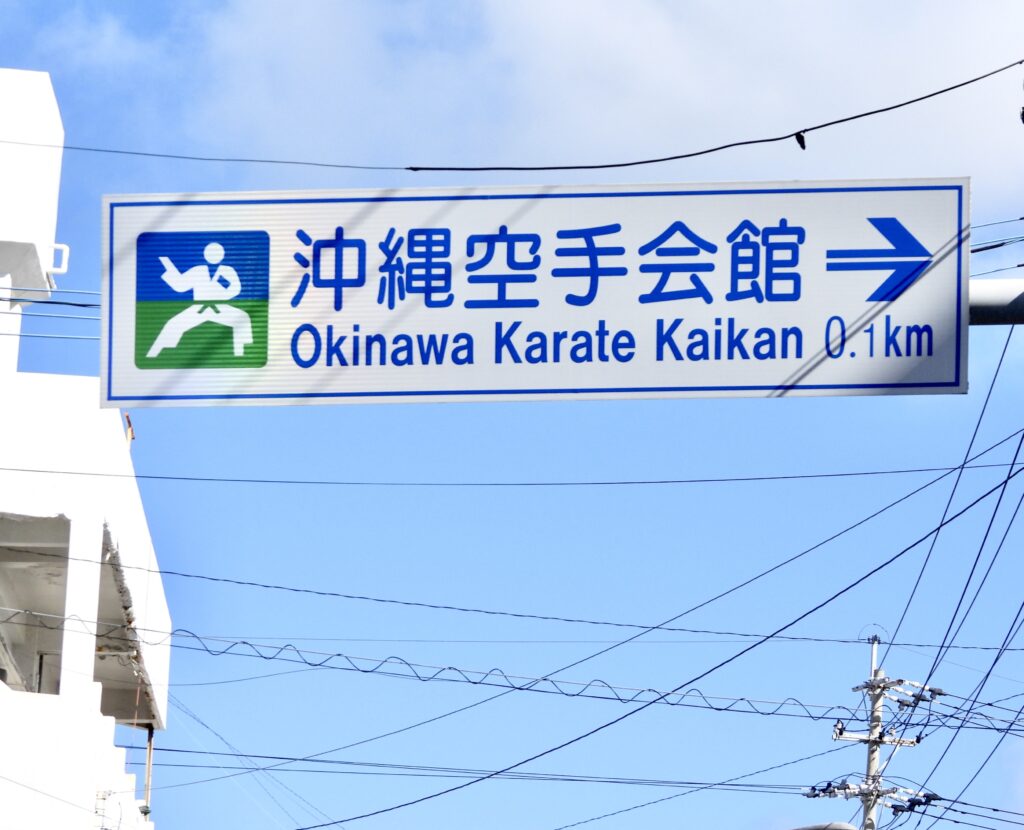
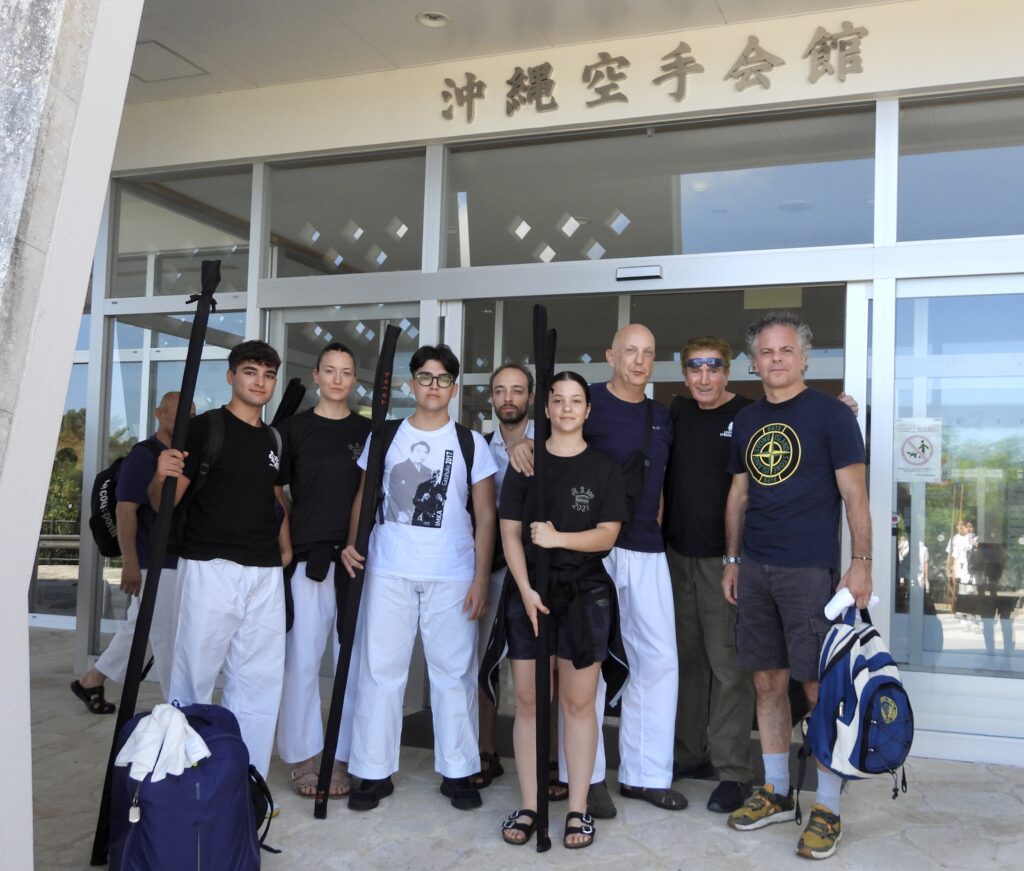
Early morning at the entrance of the “Karate Kaikan”
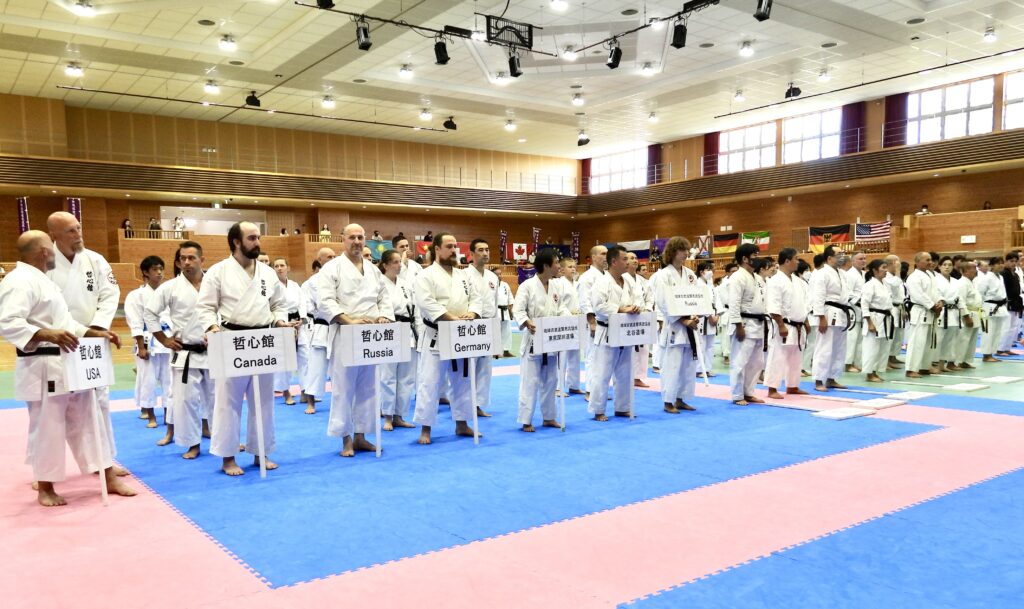
Line-up of the delegations
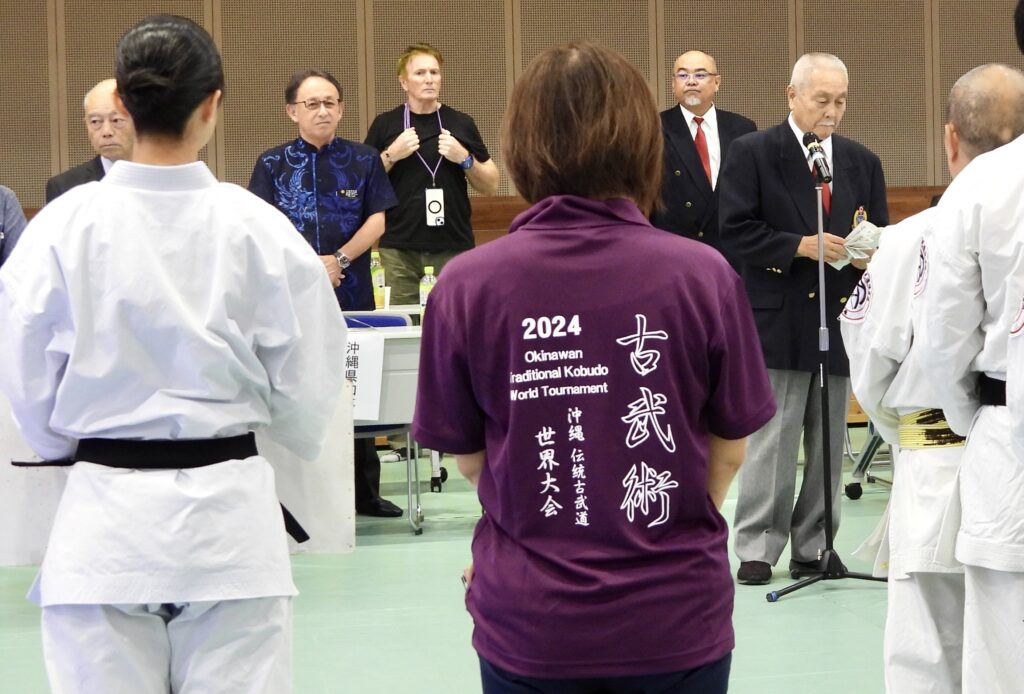
Opening ceremony with Okinawa Governor Tamaki “Denny” (left blue-shirt) who is also a Karateka
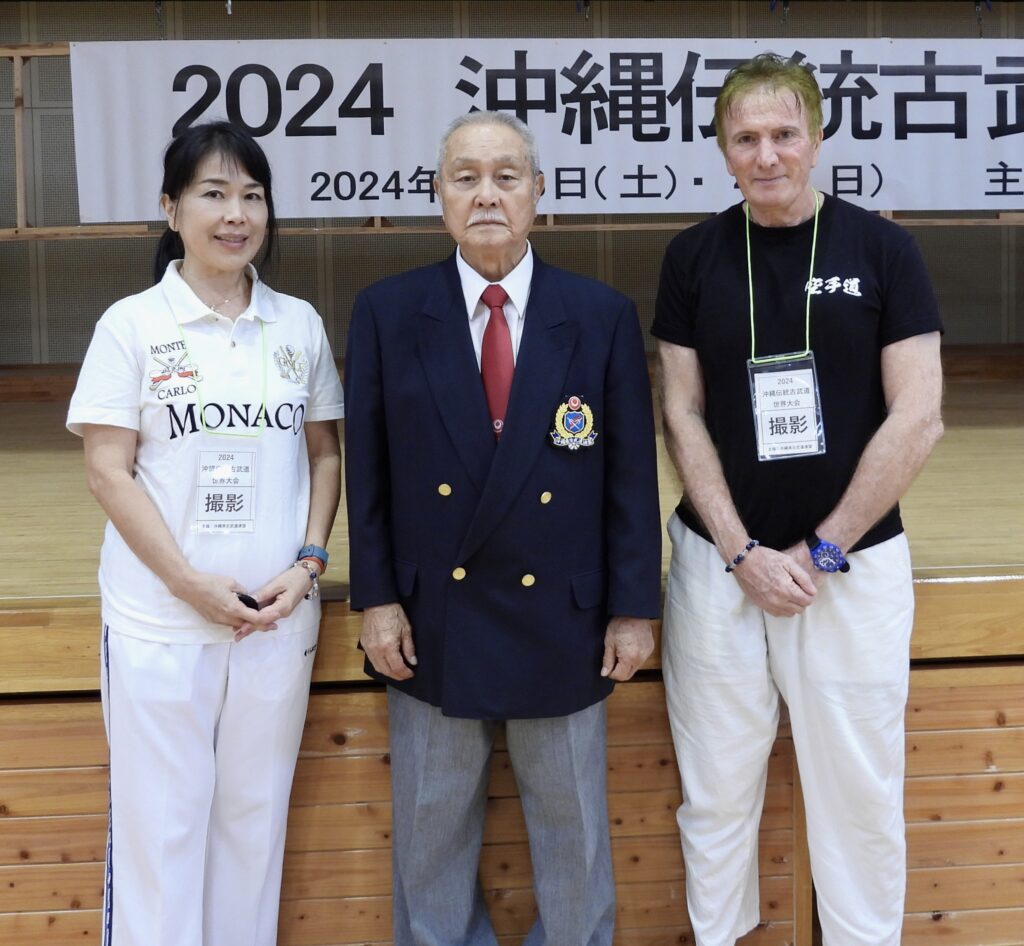
Shimabukuro Tsuneo Chairman of the Okinawa-Ken Kobudo Renmei Association and President of the World Championships, with Yuko Takahashi and Daniel Mardon
The Italians led by I.M.K.A. President Andrea Guarelli demonstrated to be a solid and enthusiastic team and they won 7 medals (4 gold, 2 silver, 1 bronze). The Russians got 6 medals (3 gold, 1 silver, 2 bronze), the Germans 3 medals (2 silver, 1 bronze), Singapore 2 medals (1 gold, 1 silver), Kazakhstan 2 medals (1 silver, 1 bronze), France 1 gold, USA 1 silver, Vietnam 1 bronze. 23 medals were won by oversea teams and 46 medals were won by Japanese mostly from Okinawa… With one-third of the medals brought home out of Japan, I felt like Okinawa’s Kobudo is steadily spreading to the world.
In brief, only 3 French Kobudoka attended and among them I found an old Shotokan mate that I had not seen for over 40 years…! Moncef Abdelwahed Sensei is the one who got a well merited gold medal in “Sai” in the 60 + category… He presented the Kata “Chatan Yara no sai” and he surprised me with his ability to show such a flexibility that most Shotokan veterans like myself have lost.
The Russian Alexey Gruzdev has won one gold in Bo and one gold in Sai in the 40-59 category. He presented a rock-solid “Shushi no kon” and “Hamahiga no sai” Kata. I would not like to have to fight this super tough competitor…
The Japanese Hiroshi Moroda won the Bo gold medal as a senior with his well-spirited “Sakugawa no kon” Kata.
The Italian Roberto Russo with his amazing jumping abilities won gold & silver with “Shinbaru no sai”and “Tokumine no kon”.
The sparkling and charming Stephanie Dahlke, a regular participant from Germany, won silver & bronze with “Shirataru no kon” and “Hamahiga no sai”. Her swift and brilliant moves are her trademark.
The Juniors displayed excellent capacities which guarantee quality for the future of Kobudo.
Last, but not the least, we could appreciate an excellent level among the women from all countries who demonstrated excellent skills in mastering this difficult art and discipline.
Bo-Kumite was a first for me and I could only compare it to Kendo. It was quite spectacular and only the Japanese scored at it.
Kobudo seems to have a promising future…
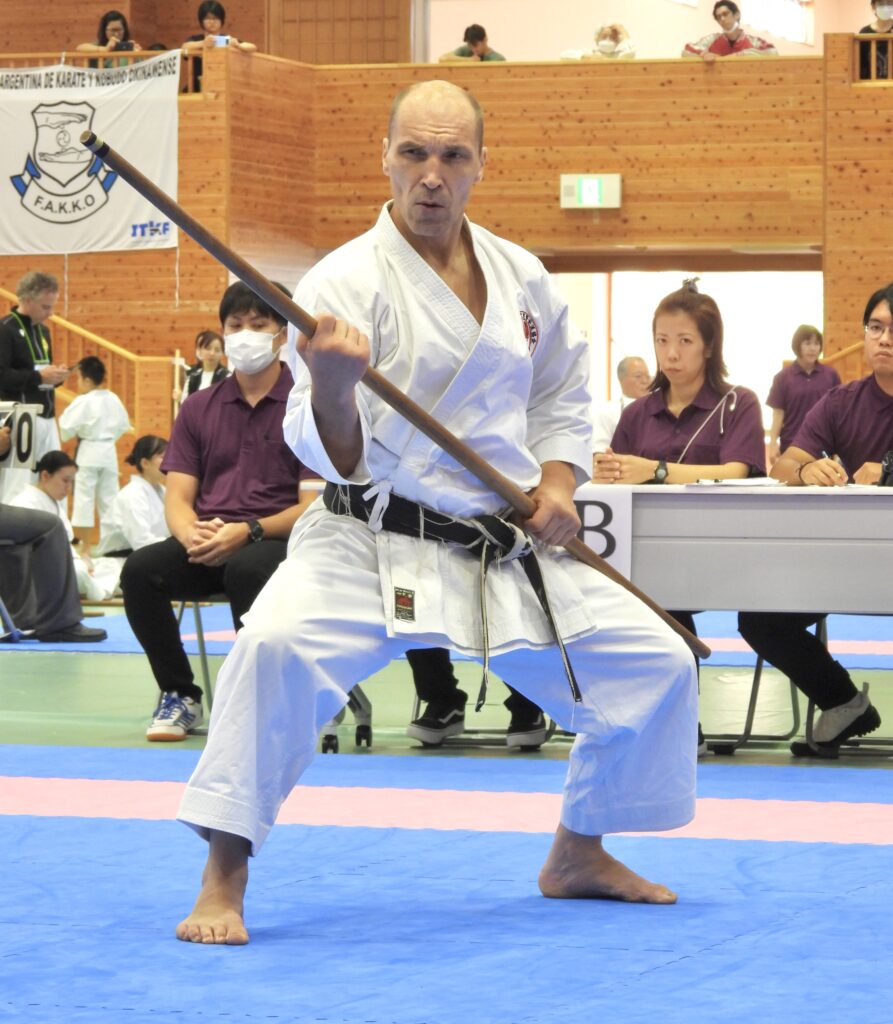
Alexey Gruzdev (Russia) during the finals
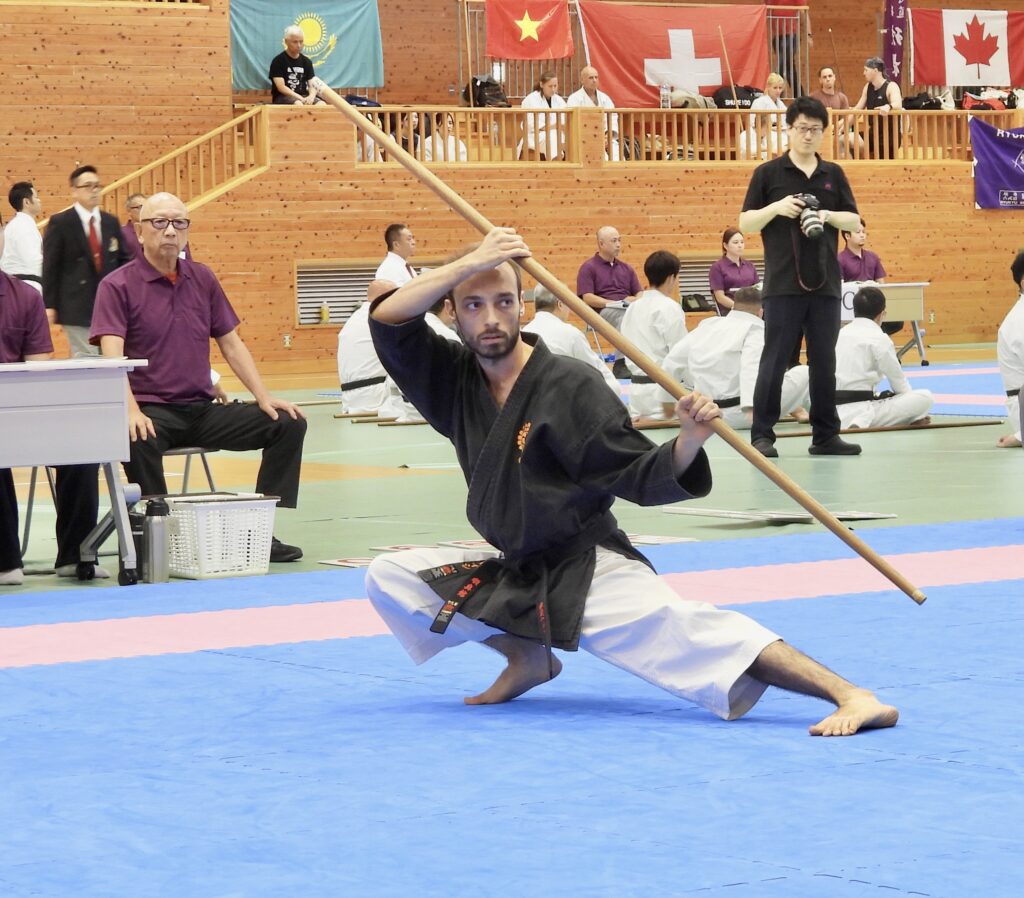
Roberto Russo (Italy) with his impressive moves
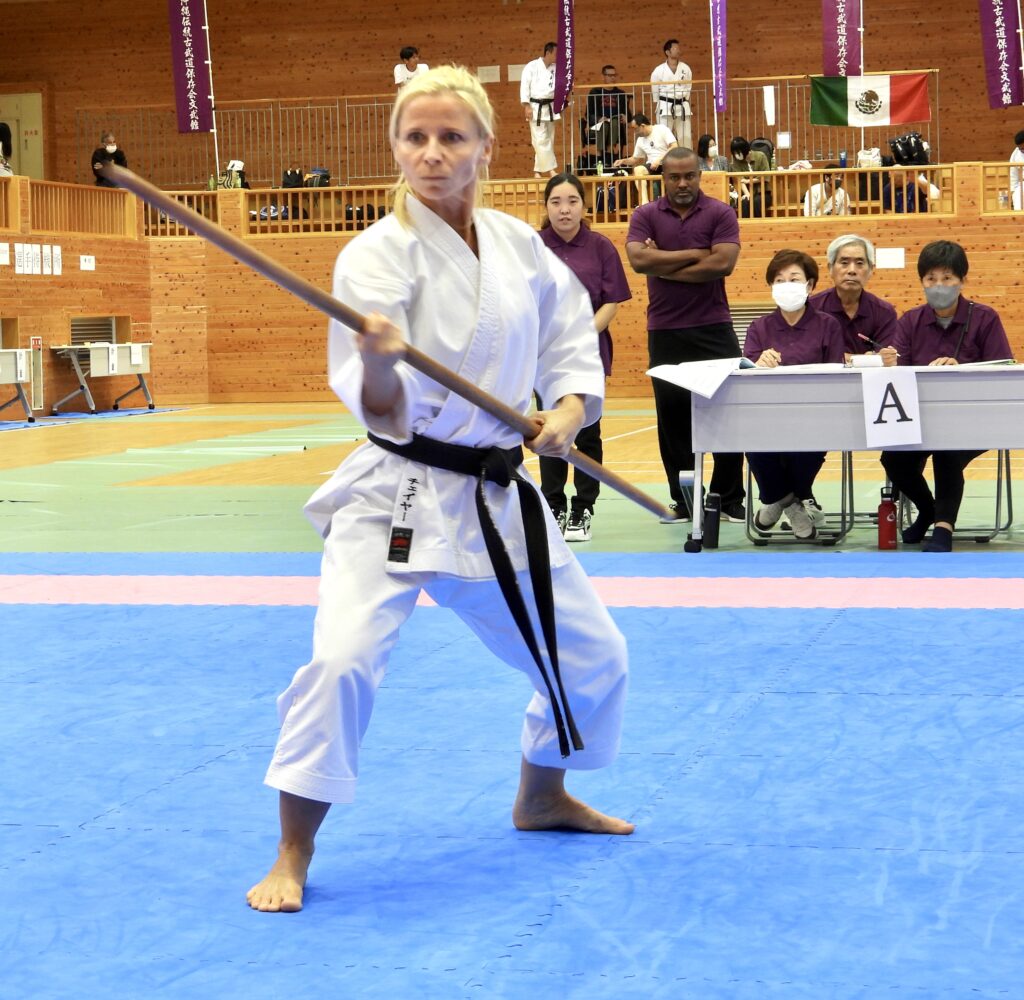
Stephanie Dahlke (Germany) in action
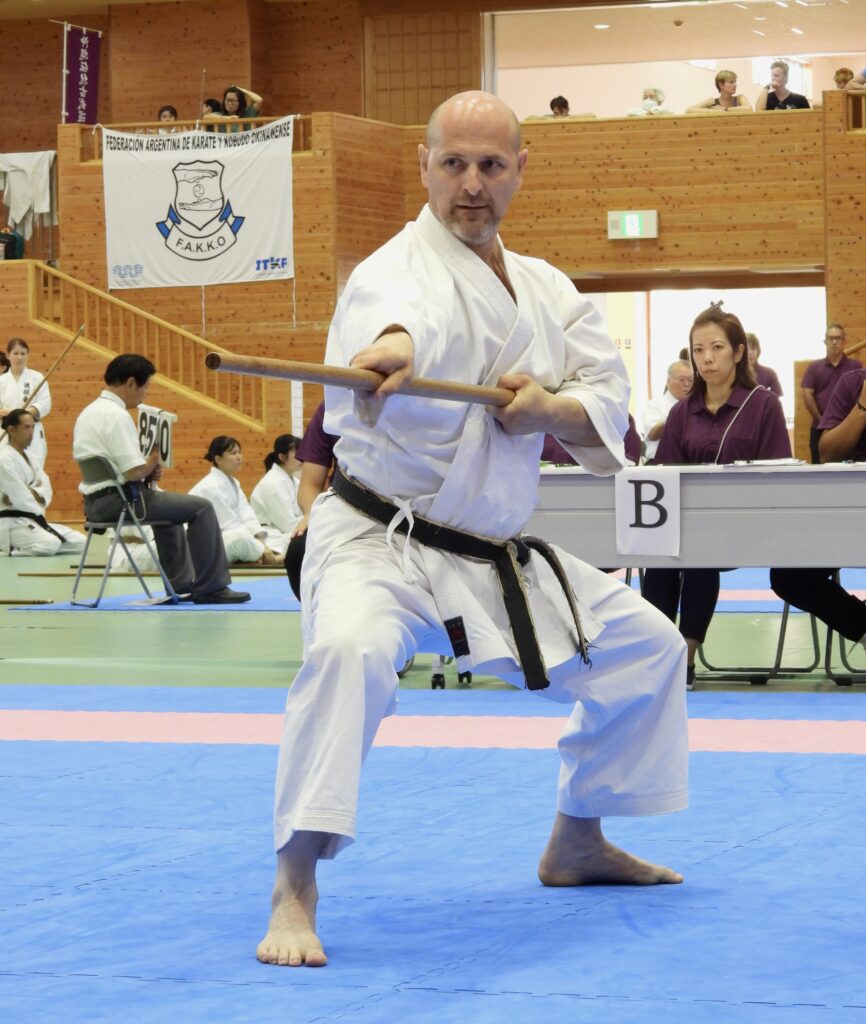
Pavel Dolgachev (Russia) won the bronze!
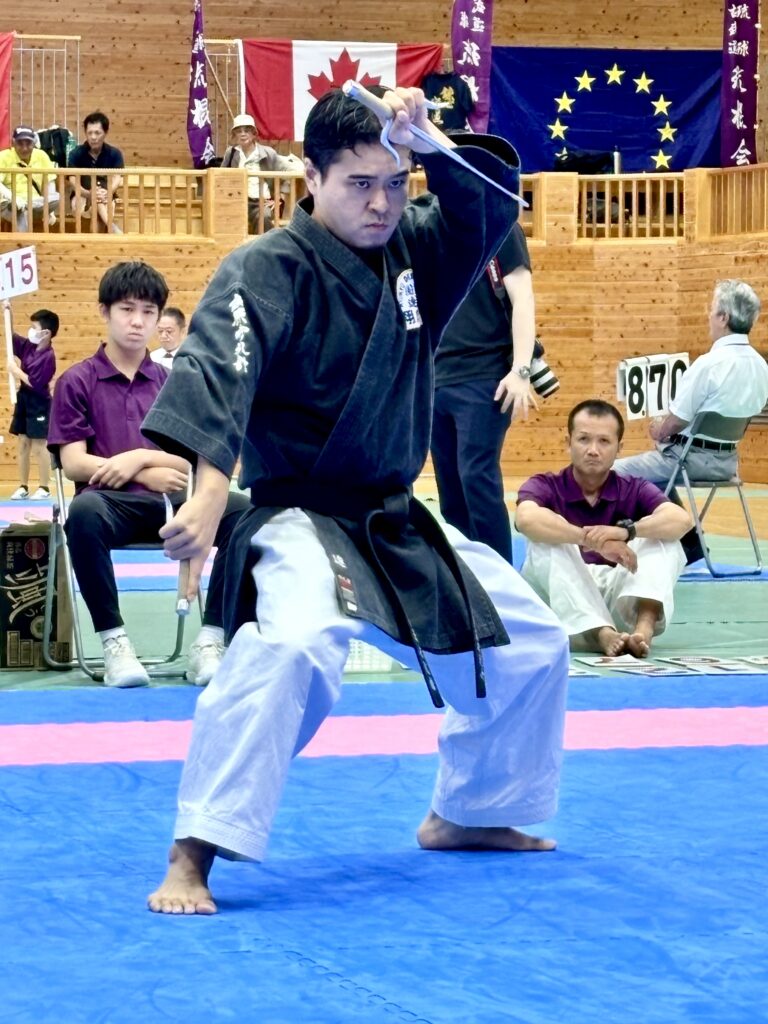
Shimabukuro Ren with Sai
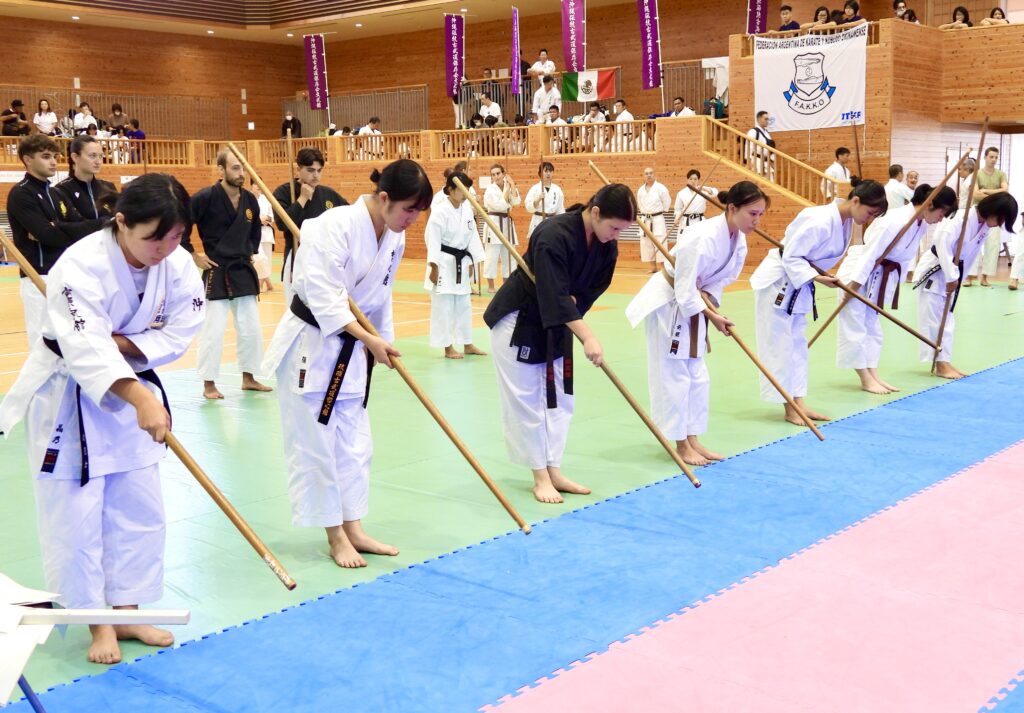
The 15-18 women’s line-up
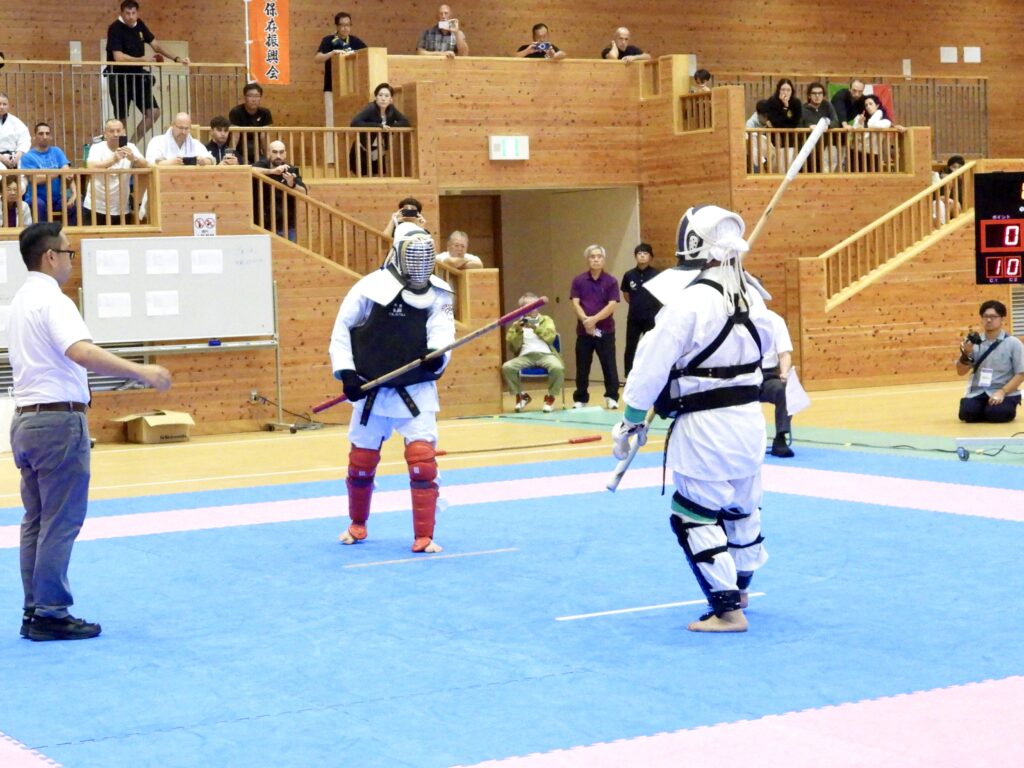
Bo-Kumite, a very exciting moment
Kobudo, Kobujutsu, Budo, Bujutsu, Jujutsu, Karate…
Before I moved to Japan and especially to Okinawa, I was in total ignorance of the true definition of these terms as well as many other technical names. Japanese is not an easy language that we can manipulate and a same Kanji can mean many different things. For many of us, we find out too late that we were taught mistakes back home, both in our Karate and in the names and it is very saddening. One day, we have to face the fact that we didn’t know that we didn’t know. Once we learn and discover that we now know what we didn’t know, we can humbly accept the lesson or choose to reject and argue because it is too hard to accept that we have learned wrong things. Of course, history is not a science and is often based on speculative conclusions, especially in the case of Okinawa, which possesses very little written documents. However, by havin g a professional relationship with the greatest Masters who are still closely connected to the roots, we learn a quite similar story from all of them.
First of all, let’s define those different terms.
“Ko” (old) “Bu” (war) “Do” (way) refers to the traditional Mainland-Japan fighting techniques from the pre-Edo and Edo periods. Indeed, these ancients’Japanese martial arts were mainly created from the end of the Heian period (794-1185) through the Kamakura period (1185-1333), the Muromachi period (1336-1573) and finally through the Sengoku period (1467-1603). During the peaceful Edo period (1603-1868), techniques and mental training were still studied, but philosophy and other arts became part of the development of a new form of Kobudo, which gave rise to the concept of “Budo”. The Kanji character “Do” also has the signification of road, path, morality, reason and field of expertise and that is why that combination “Budo” has become a broader name that is very much in use nowadays for many things, which are not directly linked to warriors… In the Edo period, martial arts were considered to be the essential part of the Samurai’s cursus. Each feudal domain possessed some secret ancient martial arts that were preserved and that have been passed down to the present day.
War techniques such as archery, sword fighting, combat from horses, jujutsu, etc… were greatly elaborated during the Edo period.
In general, martial arts that existed before the 1868 Meiji Restoration
(Modernization of Japan) are considered “Ko-bu-do”, while those created after, are considered modern (Gendai) Budo. Since “Ko” refers to “old”, ancient Jujutsu 柔術 is technically Kobudo, despite it being a fighting technique with no weapons. Jujutsu can be best defined by “Non-intentionally lethal bare-hand-defense using body’s flexibility and the opponent’s own power”…. Japanese is a very complicated language that cannot provide easy & short answers like our cultures want to get. Jigoro Kano Sensei (1860-1932) founded his Judo with the concept of Jujutsu, but Judo cannot be Kobudo…
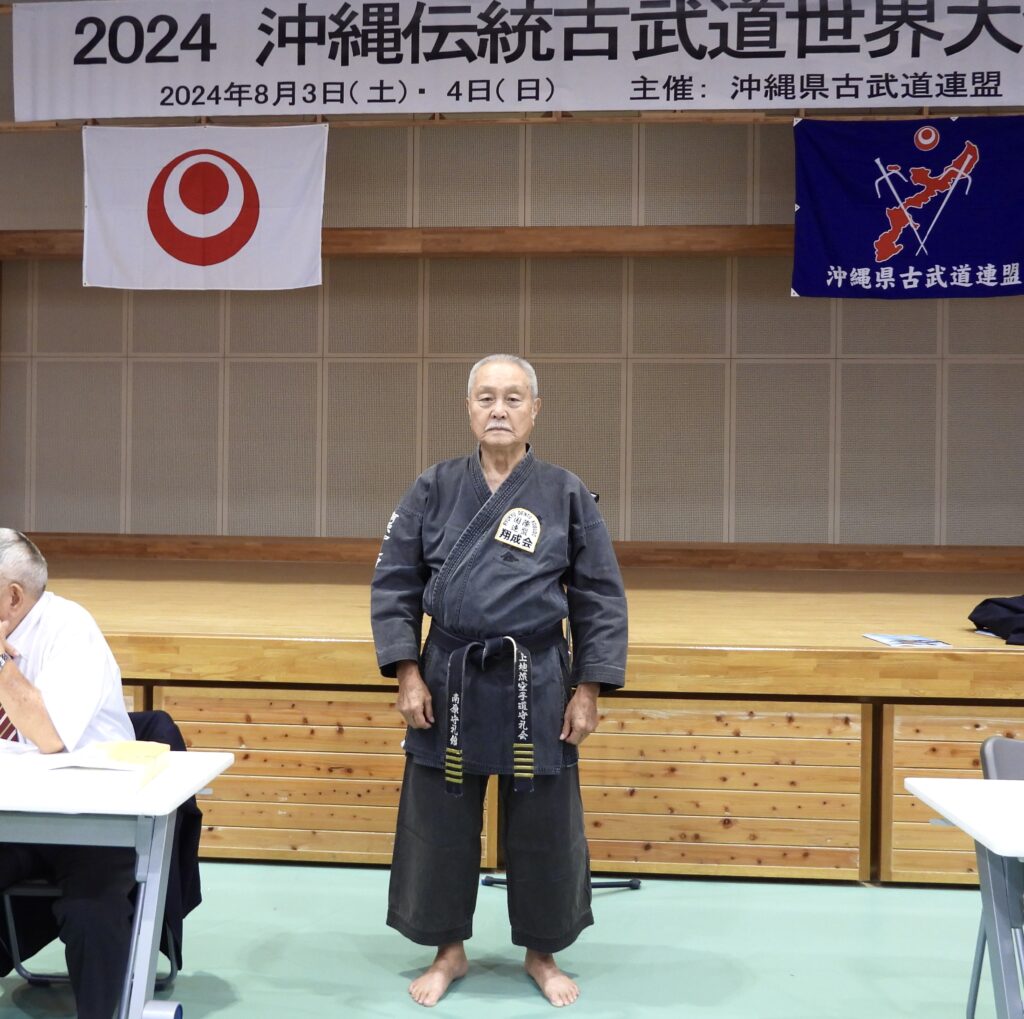
Shimabukuro Tsuneo just changed from his official suit to his Karate-Gi for the Masters’ demonstration
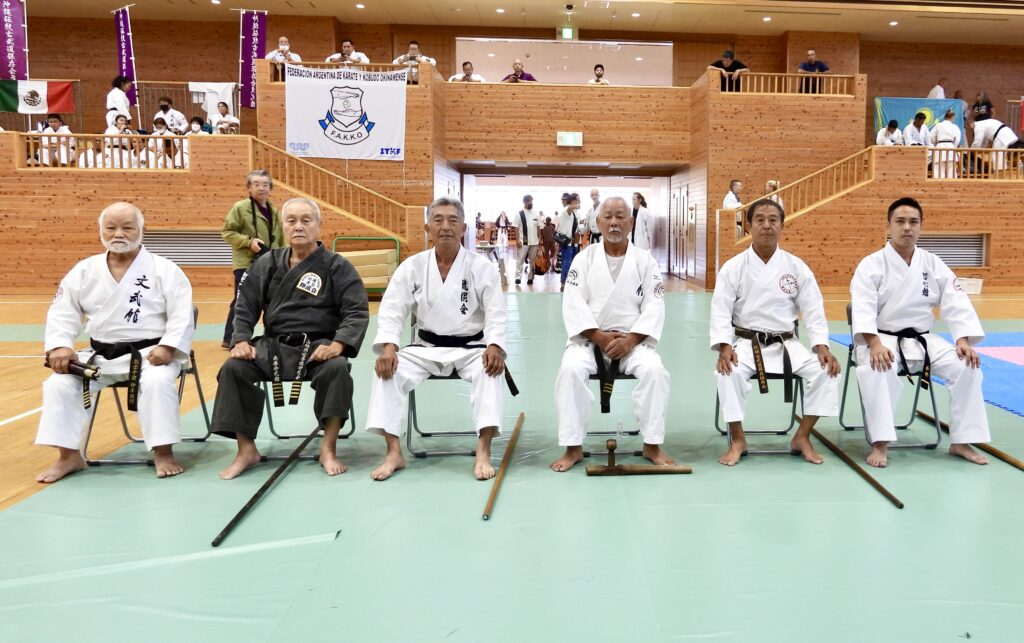
Precious demonstration by Okinawa top experts; (from left to right) Nakamoto Masahiro, Shimabukuro Tsuneo, Nakasone Seinei, Nakamori Takashi, Kuniyoshi Yukio, Tamayose Tetsushi
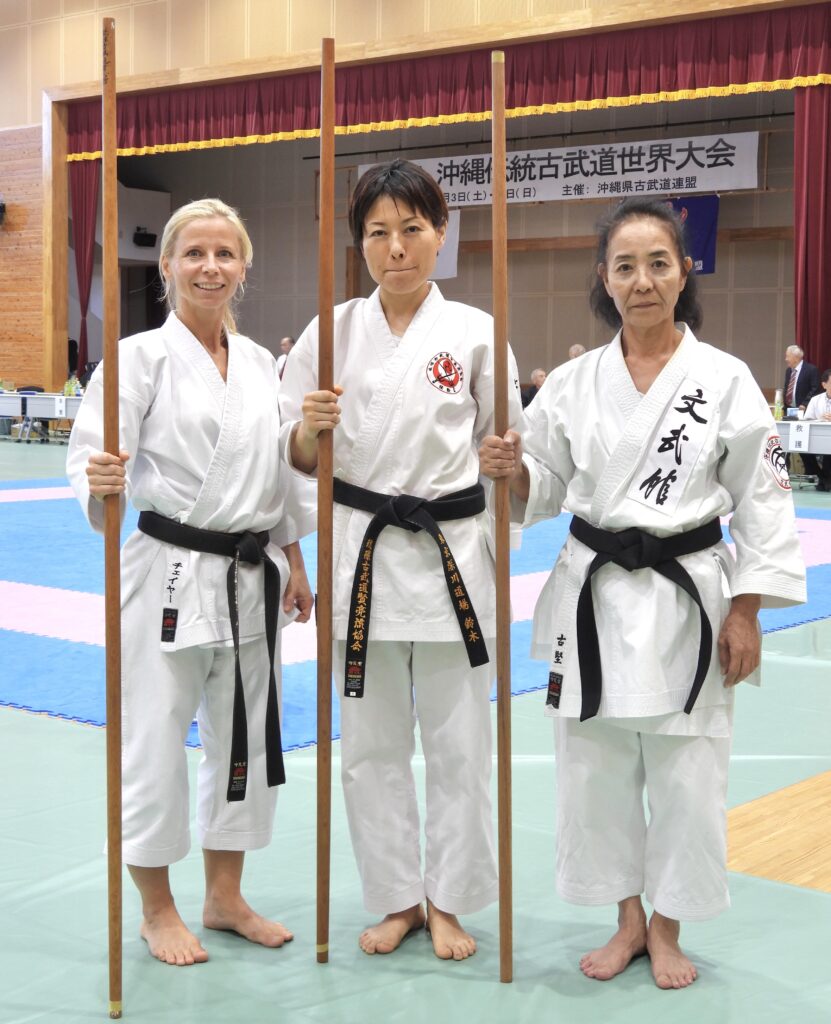
Three females “Bo”champions; Stephanie Dahlke (silver), Suzuki Mayumi (Gold) and Furugen Reiko (Bronze)
Okinawa Kobudo
The Ryukyu, which became Okinawa in 1879, also share a similar ancient Kobudo created through their long history and culture with foreign influences. However, a very specific Okinawa Kobudo was mostly developed at the end of the 19th century using familiar utensils that became formidable weapons. That Kobudo may seem rudimentary, but is very varied and ingenious. Some people therefore name it “Gendai-Kobudo” (modern Kobudo). Traces of ancient feudal Kobudo persist in the Motobu Udundi school; founded by Prince Motobu Chohei (1655-1687), which constitutes the secret martial art of the Ryukyu royal family that has been passed down through the generations. You can see more details here on “Budo-Japan”, in the translated article I had made for “Hiden Budo & Bujutsu”, Oct 2023, about the “Moidi Motobu-Ryu with Yagi Isao Sensei.
Two main streams co-exist and are referred worldwide as “Okinawa Kobudo” and “Ryukyu Kobudo”. Although both share a common origin that everyone agrees to recognize, the two main federations were created at different, but relatively recent, periods. The “Motobu-Ryu Royal Palace Guards fighting system” named above is accepted as a third party. Same as for Karate, Kobudo suffers from many divisions.
Okinawa Kobudo is often called “Matayoshi Kobudo”, due to its family origin of the same name that goes back 9 generations. However, the creation of the “Matayoshi Kobudo” groups dates back to the 70’s, while the “Ryukyu Kobudo”, was previously created in 1955 by Taira Shinken Sensei (1897-1970) who originated from Sakugawa Kanga (1762-1843)
Master Taira Shinken is highly respected and is recognized as “The father of Modern Kobudo”, exactly like Funakoshi Gichin is named “The father of Modern Karate”. Taira Shinken Sensei’s grave is on the island of Kumejima where he was from.
Okinawa Kobudo represents a true martial art for which traditional Masters prefer the original name “Kobujutsu” (old-war-techniques). Curiously, ancient Okinawa Karate; which used to be named “Te-i” and dates back at least to 1409, is not “Kobujutsu” per se, contrarily to Jujutsu which is part of Mainland Japan Kobudo…? However, Karate & Kobudo are always paired in Okinawa Dojo. This could mean that Karate is only borrowing the philosophy of Budo without being Bujutsu (war-technique). That can give a different perspective and belief about the idea that Karateka would be “killers”.
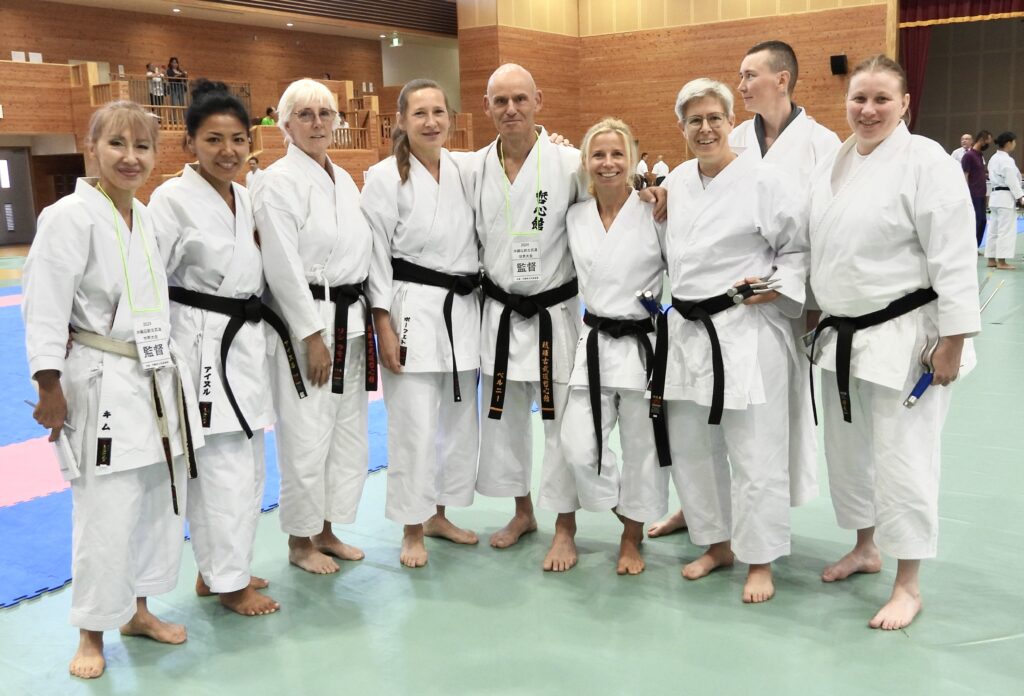
Group picture with Shihan Frank Pelny and his German team. On the left, double medal Kim Sveltlana from Kazakhstan
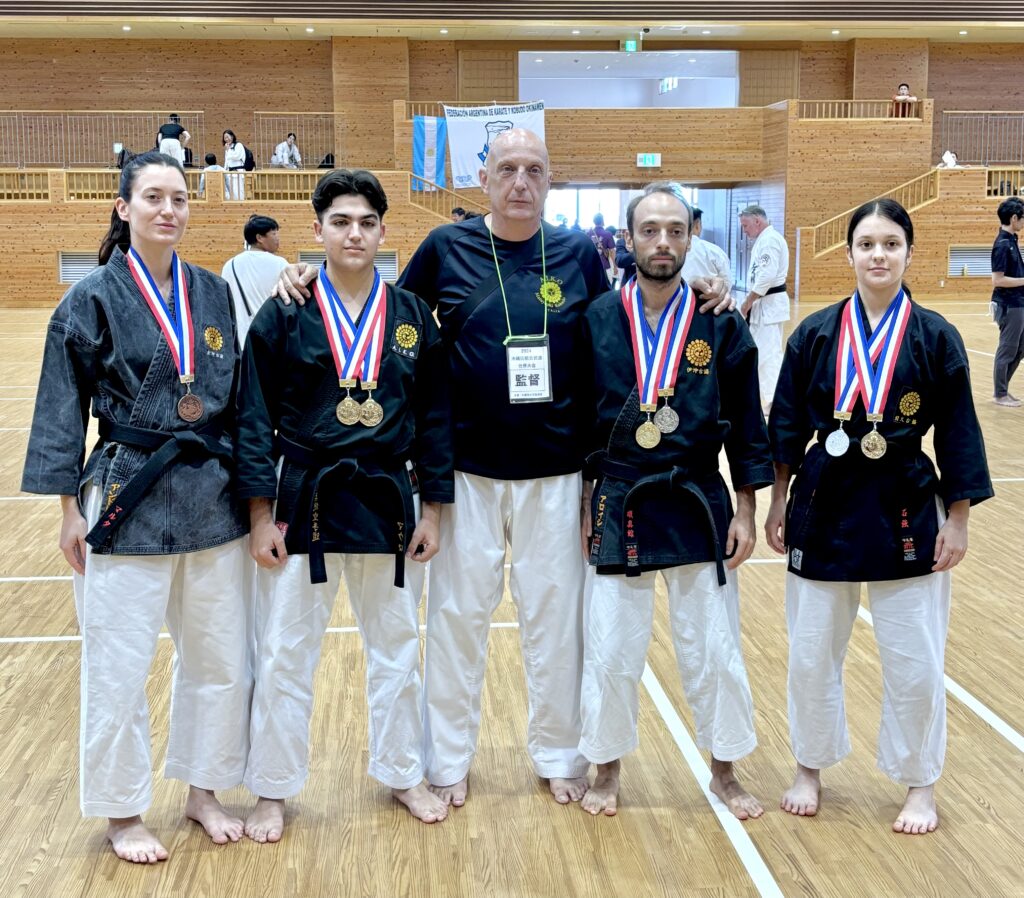
The great Italian team coached by I.M.K.A. President Andrea Guarelli
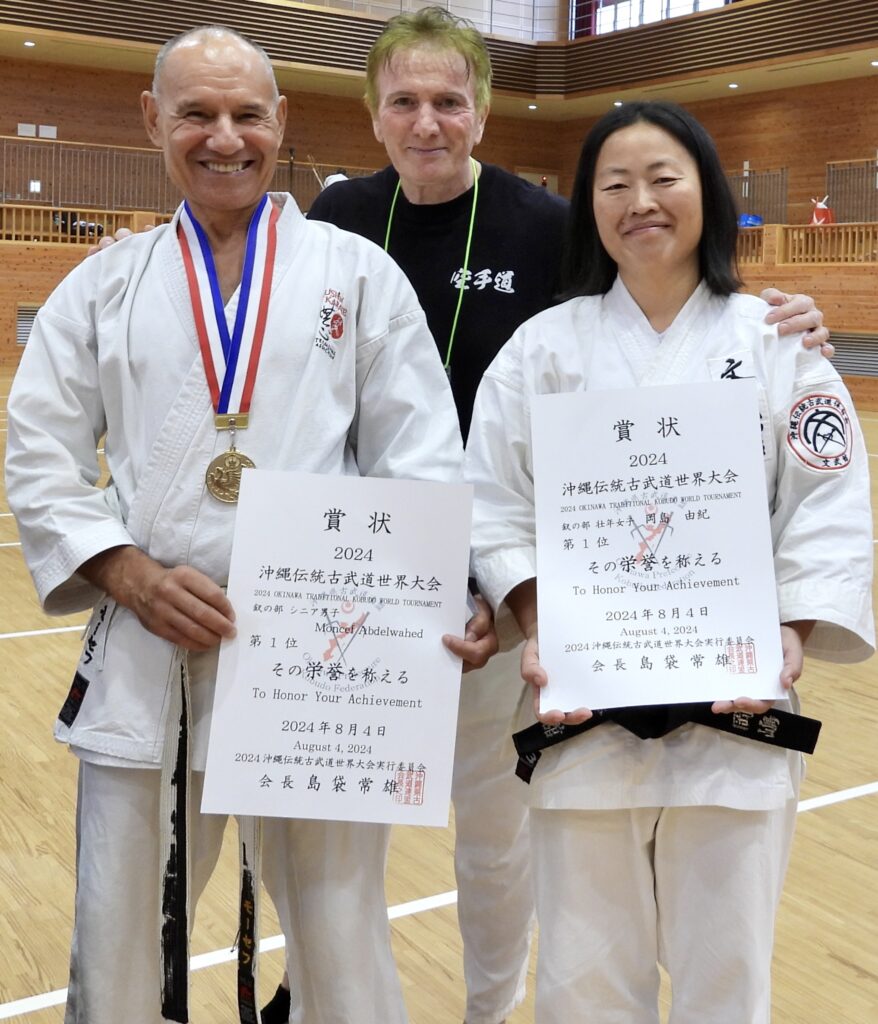
Two Gold medals in Sai; Moncef Abdelwahed & Okashima Yuki
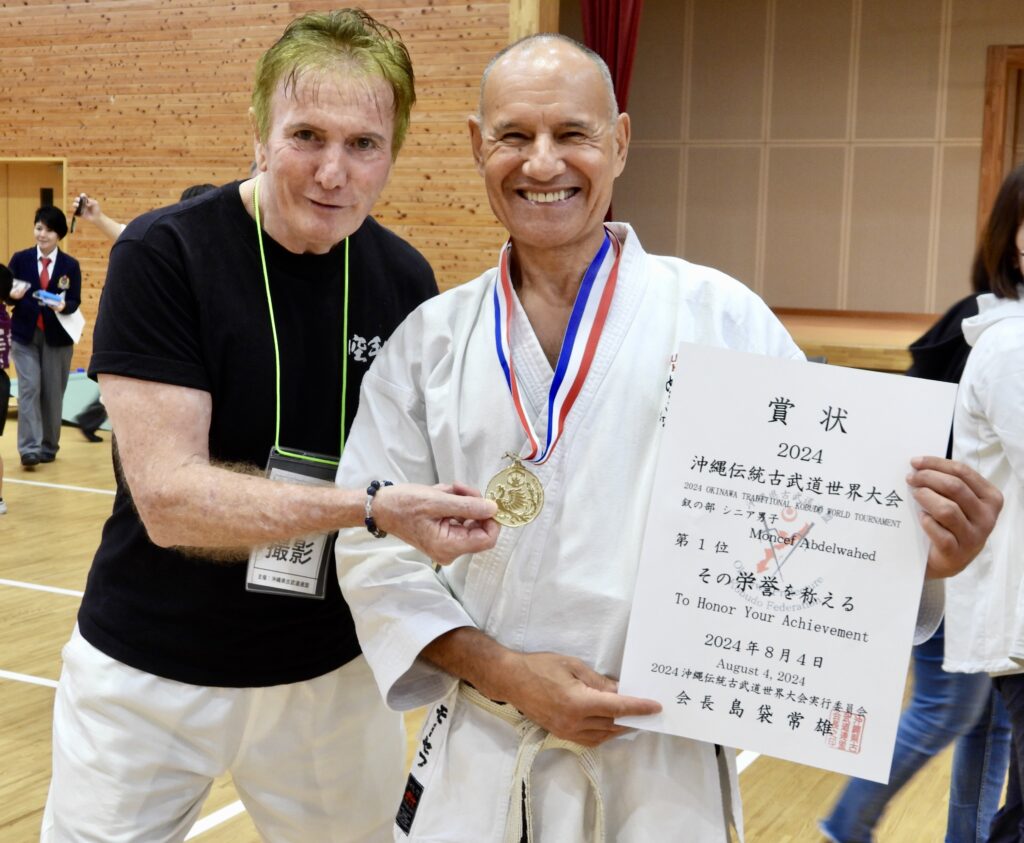
Happy to see my Shotokan mate, Moncef, from 45 years ago!
Extra precious info
Let me share with you this complement of information about the history of the Ryukyu Islands, Japan and Kobudo that I have mostly learned from Shimabukuro Tsuneo Sensei.
During Mainland-Japan’s Kamakura period (1185-1333), Okinawa had clans called Aji, who were fighting for supremacy in various places. This later turned into a conflict between the three kingdoms of Nanzan, Hokuzan, and Chuzan. The famous King Sho Hashi (1372-1439), Aji of Sashiki at that time, managed to unify the three kingdoms and in 1429 the Ryukyu Kingdom was established.
Therefore, Sho Hashi went from being the last King of Chuzan to the first King of the Ryukyu. This happened during the Muromachi Shogunate era (1336-1573) in mainland Japan and right before the country entered the Sengoku (war era). When the Onin War started in 1467, it created the collapse of the Muromachi Shogunate which went into total decline. Japan became unified as one country in 1590.
The Ryukyu Kingdom greatly developed through diplomatic trade with China, Southeast Asian countries, Korea, and Japan, and existed as a kingdom for about 450 years until the Meiji government dispossessed the Ryukyu Islands in 1879 [in 1879 the Ryukyu Kingdom was destroyed and Okinawa Prefecture was established]. Through its history and culture, the Ryukyu Islands produced a big diversity of original martial arts. While karate is about fighting bare hands, Okinawa Kobujutsu is a martial art that uses familiar tools from the Ryukyu as powerful weapons. According to Chairman Shimabukuro Tsuneo, most of the Okinawa Kobujutsu’s nomenclature was named after Ryukyu warriors or regions and it belongs to the unique historical and cultural environment of the Ryukyu. All the names and descriptions are clearly different from any Kobujutsu coming from other Prefectures and other countries. Kobujutsu is about weapon techniques that Ryukyuan predecessors created through hardship and ingenuity. For example, one famous kata is named “Tsukeno Kon” and here is its story:
-After the annexation of Ryukyu, a warrior Samurai from the royal court named Tsuken Oyakata Masanori, went to the now called “Tsuken Island” after he lost his job. He taught Bojutsu to the inhabitants as a token of gratitude for their help. This kata was named after him “Tsukeno Kon” and has been passed down to the present day-
This year’s tournament included the “Bo” 棒” and the “Sai” 釵“. Chairman Shimabukuro Tsuneo explains that the “Bo” is a particularly special and precious item in Okinawa’s traditional Kobudo. The reason is that Bo is known to have the power of warding off evil spirits. It can protect against bad luck; it purifies and it strengthens places.
During “Michijune” 道ジュネー, the popular traditional procession that parade through the tiny streets of the villages during performing arts and festivals, the head person of the procession is the Bo-Chikaya (The one that carries the Bo). In modern days, the Bo is often absent, but in villages that are keeping ancient traditions, the Bochikaya is still walking in the front position. You can see it during Okinawa, Bon 盆 , which is celebrated according to the lunar calendar, and on the last day of the lunar Bon (Ukui). The spirits of ancestors, who were welcomed with “Unkei”, are sent back to the spirit world, and prayers are made for health and safety of the household, and the “Michijune” is performed, while dancing Eisa エイサー.
When a grave has been built, a similar celebration is held in front of the grave. Ryukyuan songs are sung while playing the Sanshin and the Bo is always present. If the tomb is large enough, we enter it with a Bo, and tap it on the floor in rhythm with the music. For house or building blessings, we often play the Sanshin and do “meekata” (dancing) with Bo techniques and Karate Kata.
Finally, I wanted to ask Chairman Shimabukuro Tsuneo about the most memorable moments from his tournament and here is his answer.
-“It went very well, nobody was injured and the attendance was good. I am very concerned that Kata is moving away from our dento 伝統 (traditions) and moving towards competition. Not only the Kata techniques, but also the way of dealing with “Ma-ai” (Intervals). In both traditional Okinawan Kobudo and traditional Karate, we have the concept of “Ikkyodo” 一挙動 (one movement at a time). However, it has nowadays been broken down so much that “Ma-ai” is seen in impossible places and at impossible moments…! It seems that every technique is done one by one. In the real battles of the past and in many cases, fights were not only “one-on-one”, but one against multiple opponents and “Ma-ai” was impossible.
In Okinawan Dento Karate Kobudo, we cherish our great techniques of the past, but they are now disappearing with “Kyogi” (competition style). It feels like competitors are just doing a show to impress the judges. I am not criticizing, but I strongly feel that if we do not make an effort to protect the tradition now, it will become mostly a complete competition form”. (see more on link about Shimabukuro Sensei)
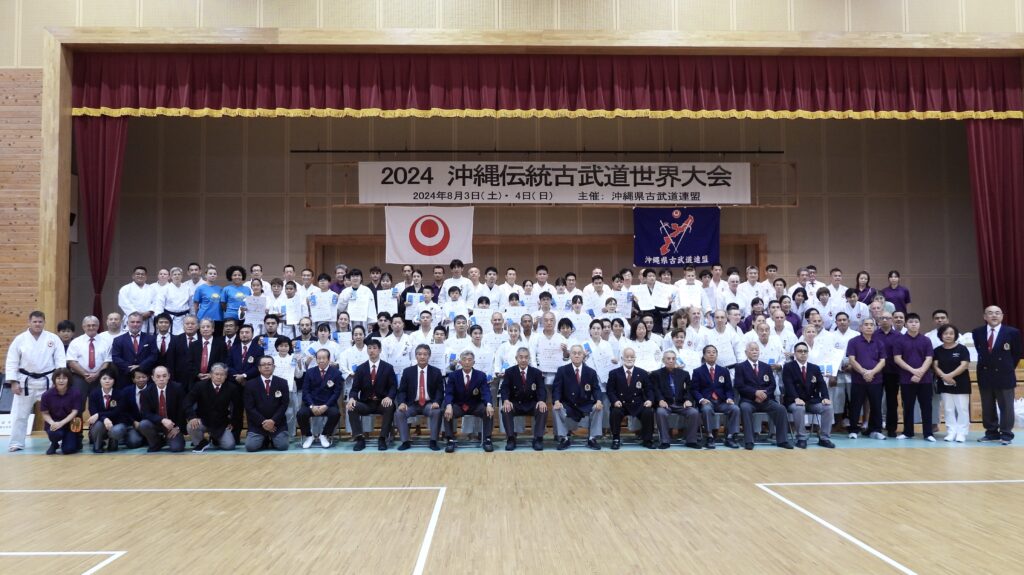
All the champions posing with some of the greatest Masters of the world
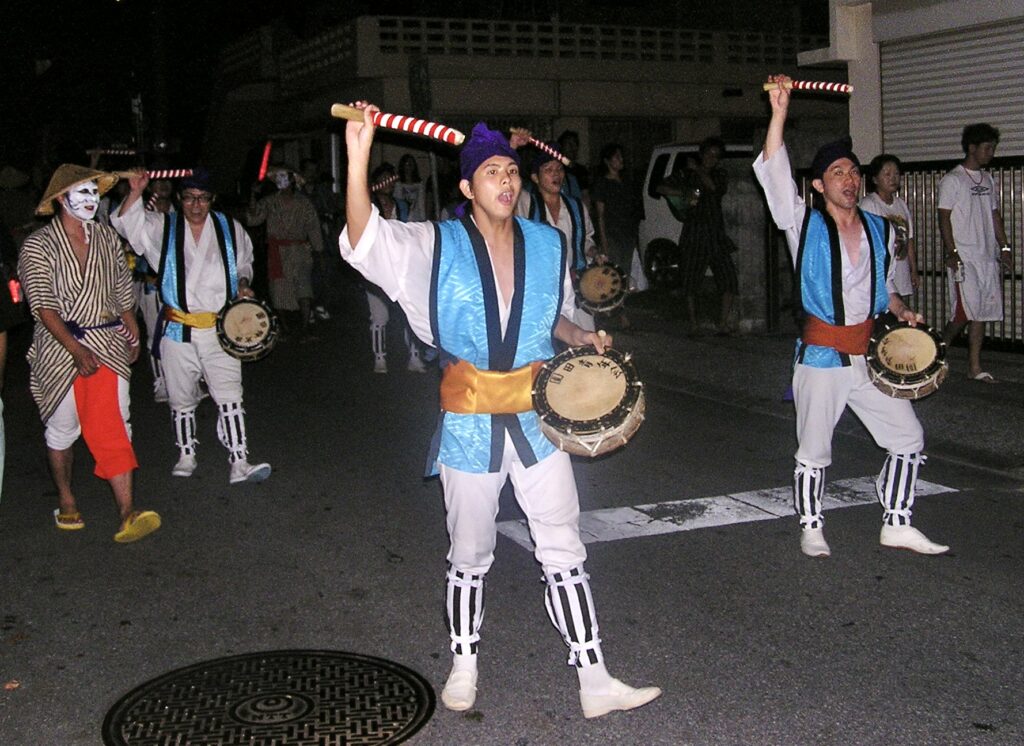
Eisa during O-Bon
-Daniel’s conclusion-
All this precious info made me understand deeper about the different Kobudo and especially how Bojutsu has been passed down in Okinawa’s culture and customs as both a martial art and as something sacred.
I already have written a lot about the rising voices of the Okinawa Masters who are very concerned about the deformation of traditional Karate into competitive Karate. They are split between giving up to world Karate or implementing true traditional Karate. Let’s make it clear, it is impossible for traditional and competitive forms to be in the same field and it is extremely difficult for judges to make fair evaluations. We need to train the foreigners and the younger judges to discern the difference between the original forms and the made-up Karate show. Japan has a variety of traditional arts and cultures that have been passed down “as is” since ancient times.
Thank you to everyone involved in the tournament and to all the participants. It was a tournament filled with kindness and goodwill.
Unfortunately, we cannot list all the names of the participants and organizers of this successful event. However, here are some extra pictures, including one with Yuteng Eden from Singapore (Gold in Bo & Silver in Sai) Kinjo Hiyori (Gold in Sai), the 4 Shimabukuro sisters (Gold & Silver), Walter Hagen (Sai) and Alain Berckmans who came all the way from Belgium to participate as a referee.
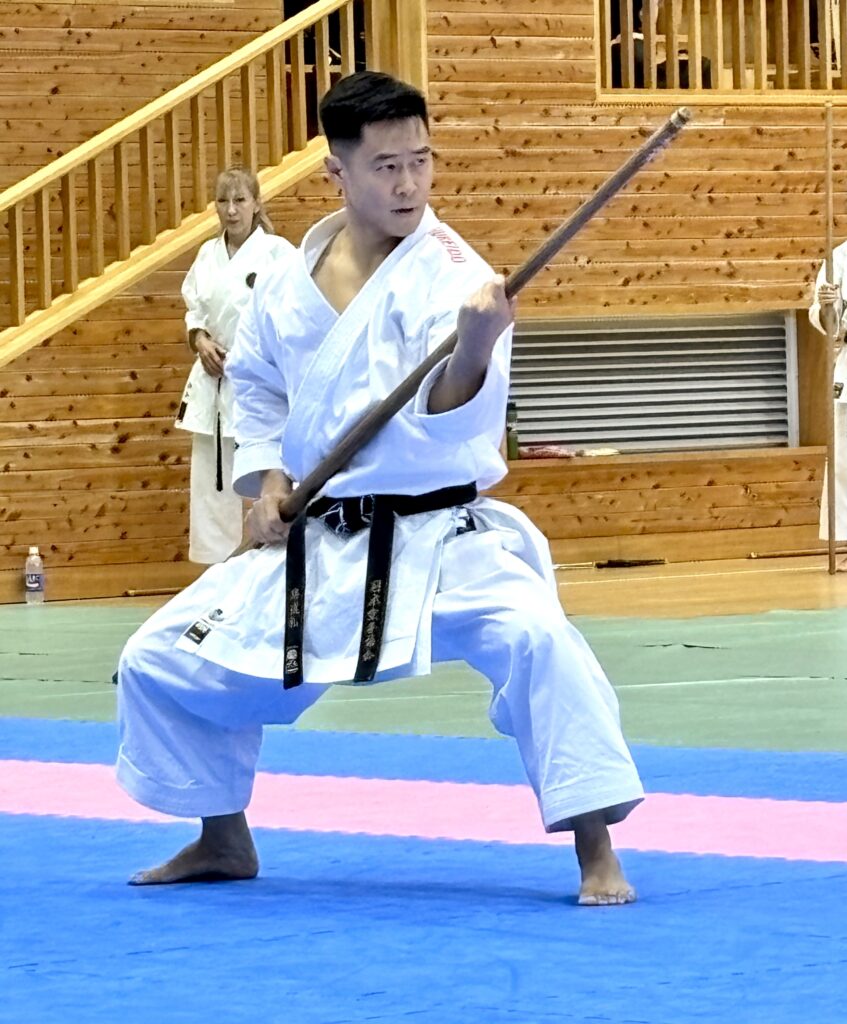
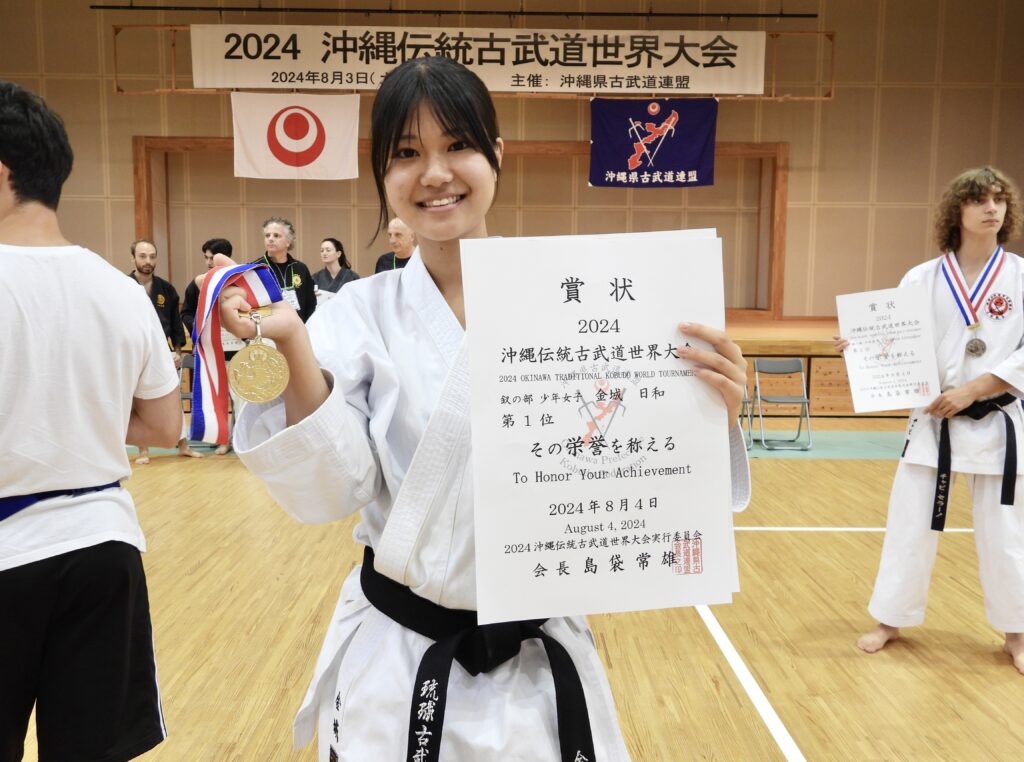
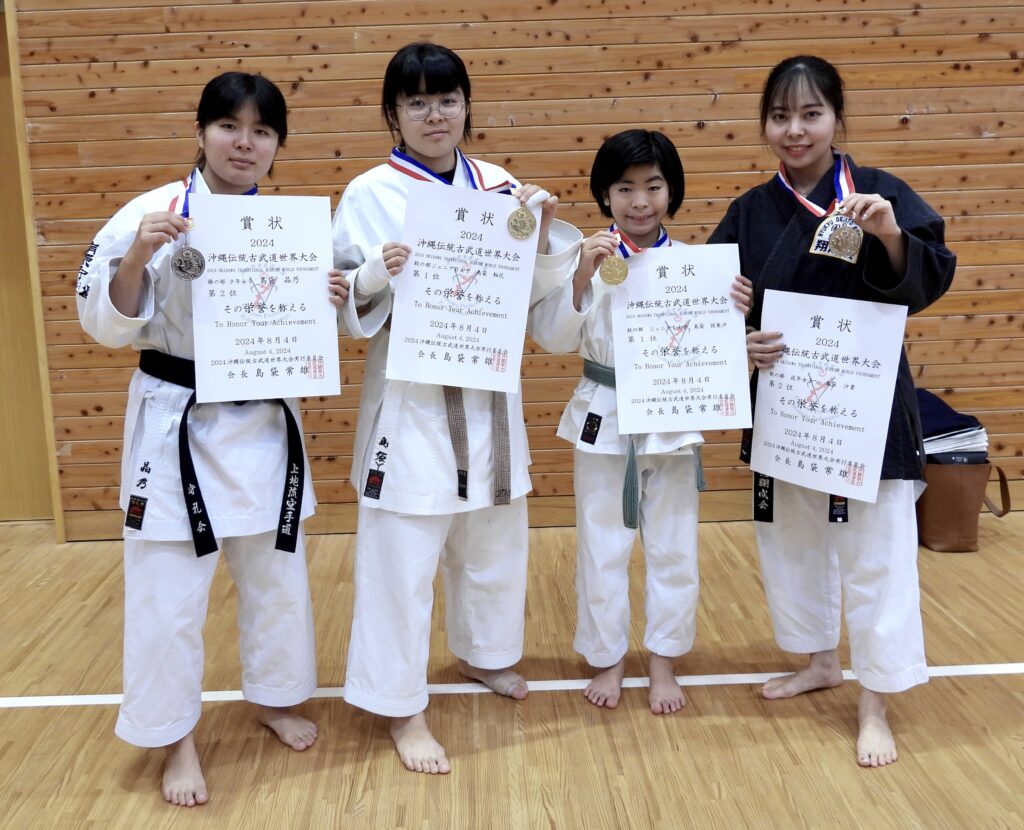
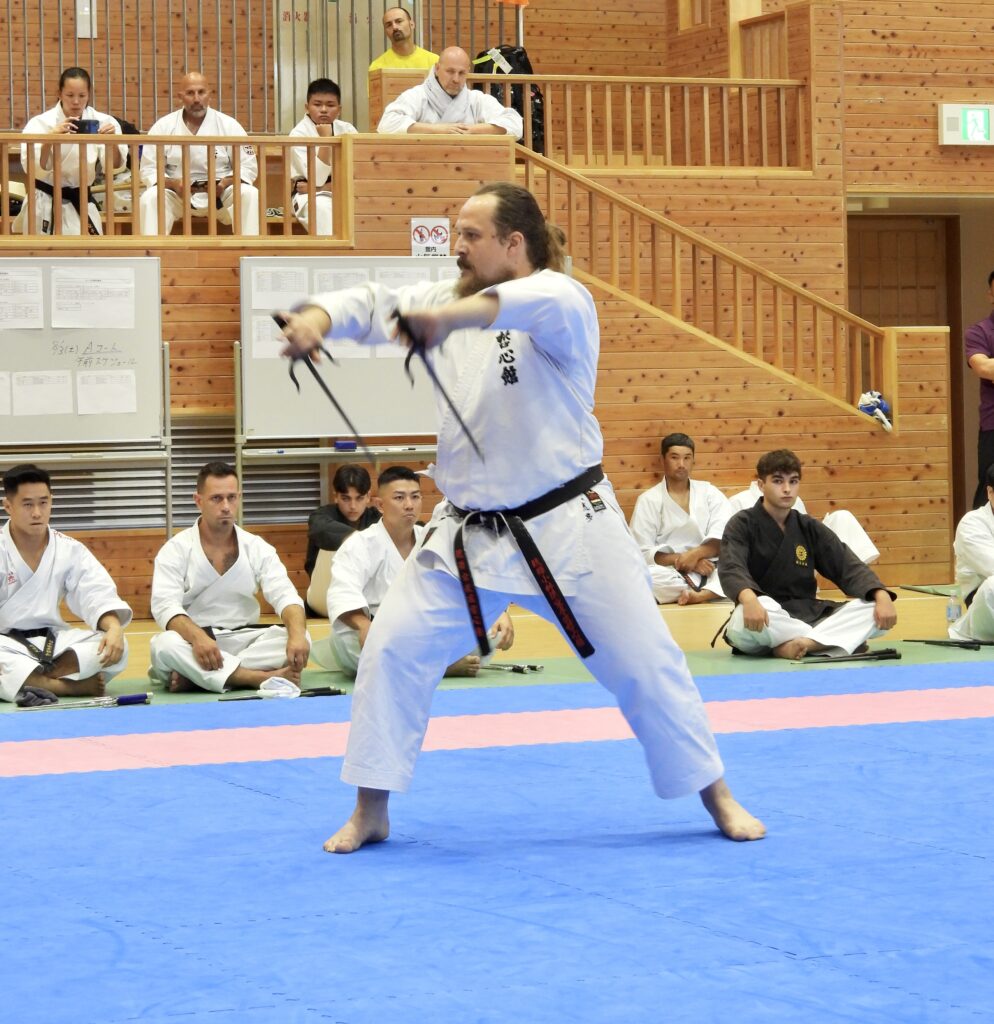
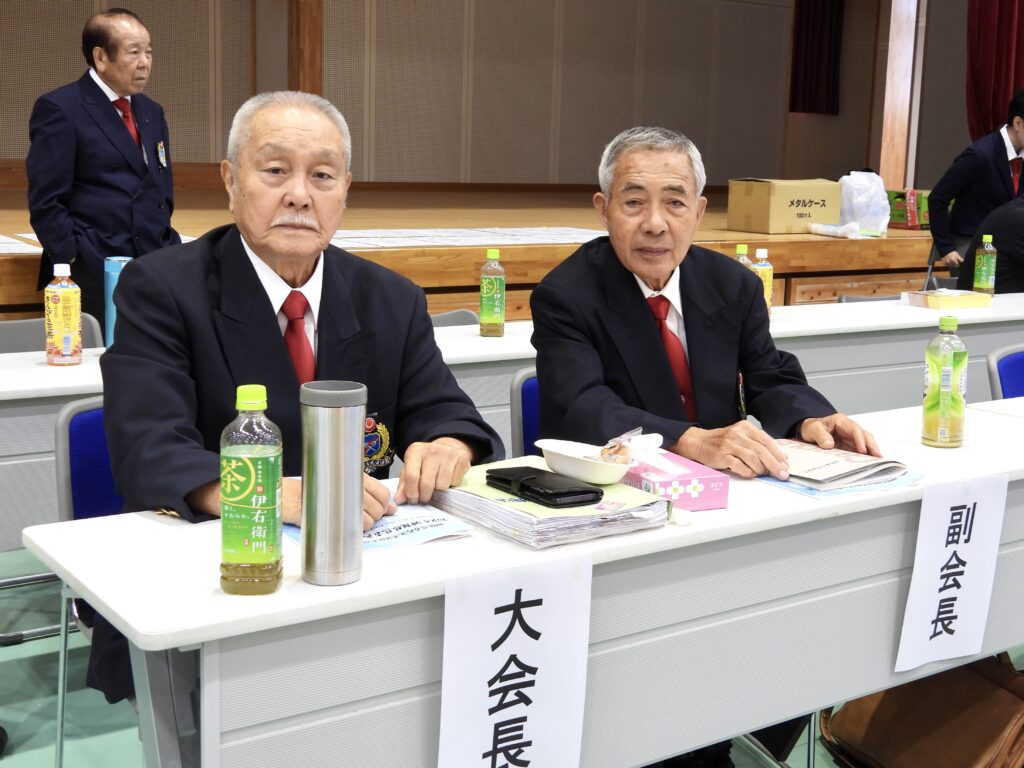
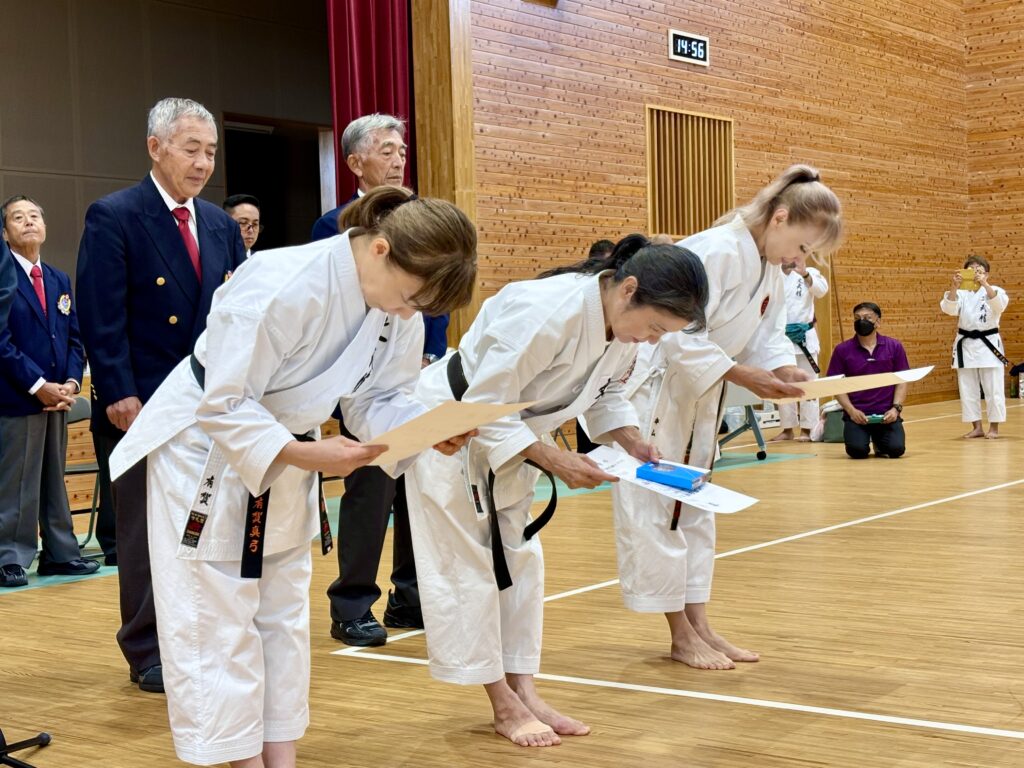
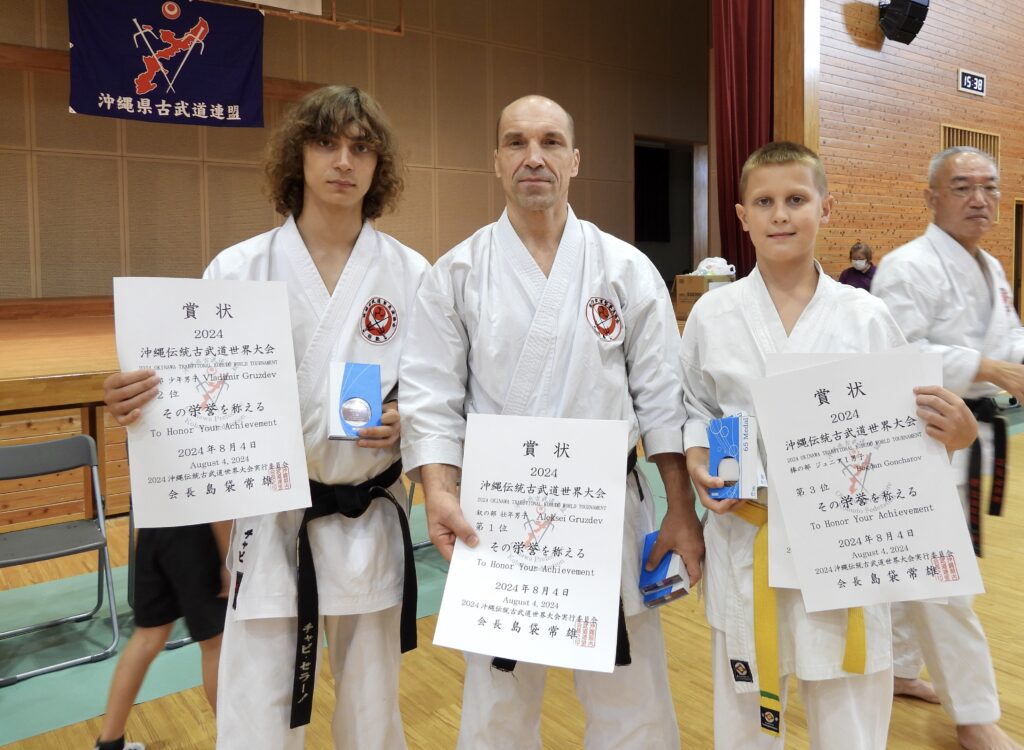
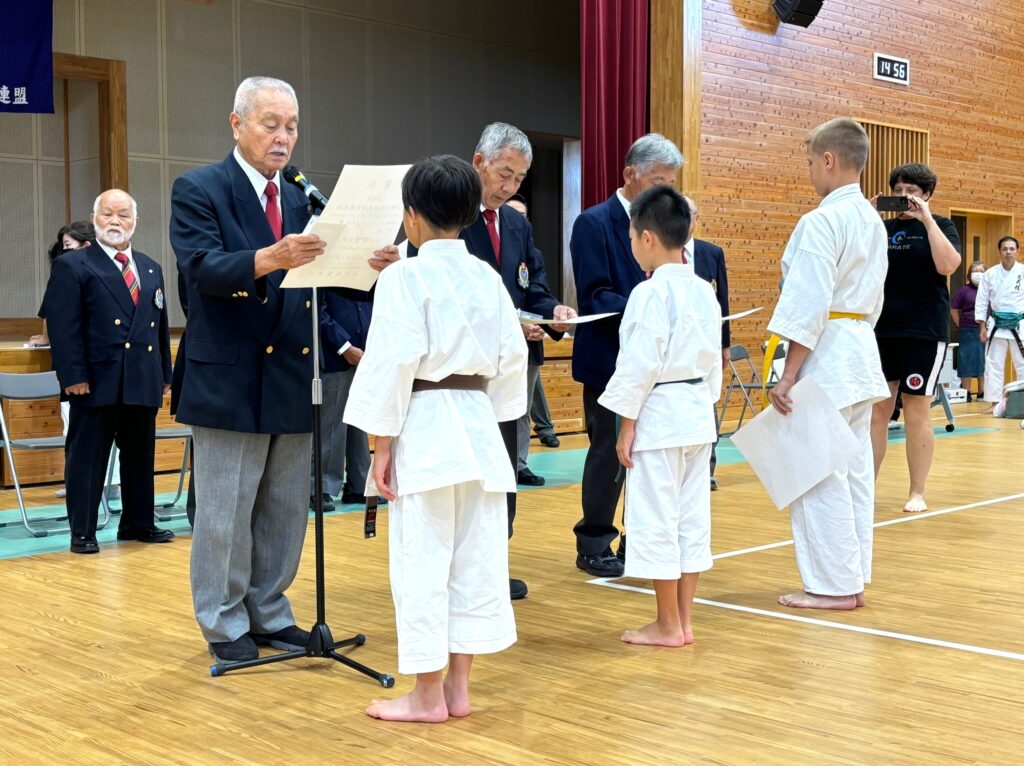
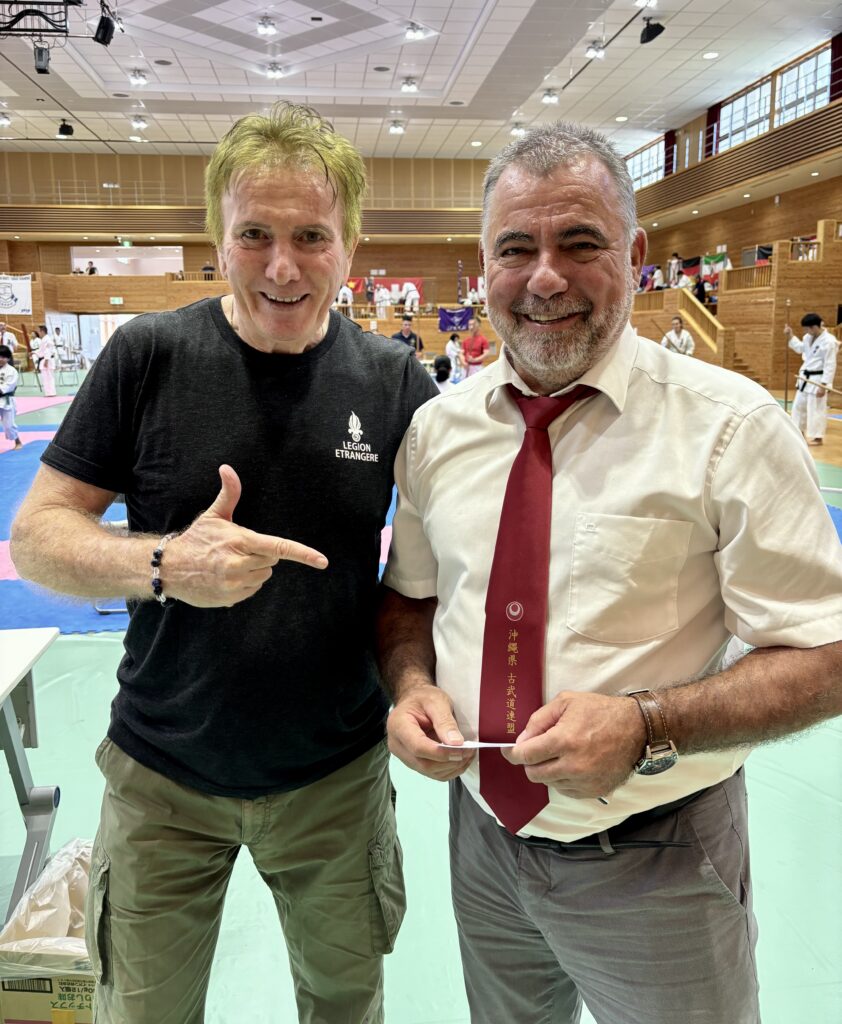
Tournament Results
サイの部
男子ジュニアI
金賞 Bogdan Goncharov
銀賞 照屋 光晟
女子ジュニアI
金賞 島袋 侑亜沙
男子ジュニアII
金賞 土子 巧真
銀賞 外間 勝希 アロン
銅賞 大山 惺楠
女子ジュニアII
金賞 島袋 釉花
銀賞 九谷 咲
男子少年
金賞 Mauro Dell’olio
女子少年
金賞 金城 日和
銀賞 Giulia Pietroforte
銅賞 前盛 佑
男子成年
金賞 Roberto Russo
銀賞 Yuteng Eden
銅賞 島袋 連
女子成年
金賞 崔 宇
銀賞 島袋 沙貴
銅賞 Marta Franchetti
男子壮年
金賞 Aleksei Gruzdev
銀賞 向谷 剛
銅賞 森根 理
女子壮年
金賞 岡島 由紀
銀賞 古堅 礼子
銅賞 Dahlke Stefanie
男子シニア
金賞 Moncef Abdelwahed
銀賞 Pelny Frank
銅賞 Le Cong
女子シニア
金賞 有賀 真弓
銀賞 喜舎場 広子
銅賞 Kim Svetlana
棒の部
男子ジュニアI
金賞 九谷 慶
銀賞 仲宗根 佑
銅賞 Bogdan Goncharov
女子ジュニアI
金賞 兼本 瑠音
銀賞 名嘉山 明李
銅賞 諸見里 莉咲
男子ジュニアII
金賞 伊良波 駿
銀賞 横田 龍輝
銅賞 土子 巧真
女子ジュニアII
金賞 九谷 咲
銀賞 名嘉山 弥花
銅賞 鈴木 智子
男子少年
金賞 Mauro Dell’olio
銀賞 Vladimir Gruzdev
女子少年
金賞 Giulia Pietroforte
銀賞 島袋 晶乃
銅賞 金城 日和
男子成年
金賞 Yuteng Eden
銀賞 Roberto Russo
銅賞 宮城 翔也
女子成年
金賞 胡 樂敏
銀賞 崔 宇
銅賞 喜屋武 水樹
男子壮年
金賞 Aleksei Gruzdev
銀賞 新里 マルコ
銅賞 Dolgachev Pavel
女子壮年
金賞 鈴木 真弓
銀賞 Dahlke Stefanie
銅賞 古堅 礼子
男子シニア
金賞 諸田 博
銀賞 Brian Ash
銅賞 仲村 春孝
女子シニア
金賞 喜舍場 広子
銀賞 Kim Svetlana
銅賞 有賀 真弓
棒組手
第一位 山田 雄二
第二位 信田 法世
第三位 津波 一秋
第四位 田中 康太
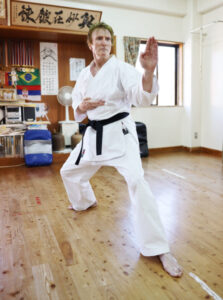
Daniel Mardon; the Karateka-Therapist
Creator of Aromapressure® method and physiotherapist with a valid US license, Daniel Mardon was born in Paris. One of his specialties is to teach and to perform lymphedema and subcutaneous tissue-damage care, after radiotherapy for cancer patients at medical institutions and subcutaneous tissue-circulation stimulation before and after surgery.
He was also a therapist for two famous soccer teams in Paris. Since 2005, he has focused on producing top-class hotel spas in Japan, as well as physiotherapy education and awareness-raising activities for health care professionals. Author of several books, among his major publications includes “The Physiology and Bodywork of Physical Therapy ” (Published by BAB Japan) and DVD “Daniel Mardon Aromapressure® Method ” (Pony Canyon). He regularly appears on television and radio shows, and has featured in numerous media publications.

